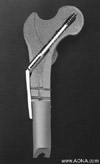Introduction to the Dynamic Hip Screw-DHS

Click for enlarged view of image
The Dynamic Hip Screw is designed to provide
strong and stable internal fixation of a variety of intertrochanteric,
subtrochanteric and basilar neck fractures, with minimal soft tissue
irritation.
Strong
-
The DHS Plates are made of 316L stainless steel and
are cold-worked for strength.
Stable
-
The number of screw holes per plate length is maximized,
without compromising plate strength. This allows an
increased number of fixation points with a smaller incision.
-
DCP (Dynamic Compression Plate) holes in the DHS side plate:
allow angulation of 4.5 mm Cortex Screws, for lag
screw fixation of medial fragments, and
allow axial compression and multiple-screw fixation
of the main fragment in subtrochanteric fractures
with shaft extension.
- Two flats within the DHS Plate barrel correspond to the
two-flat design of the DHS/DCS Lag Screw, preventing
rotation of the lag screw within the barrel. The two-flat
design also eases insertion of the plate over the
DHS/DCS Lag Screw.
Minimal Soft Tissue Irritation
- The DHS Plates have a low-profile design, reducing the
risk of trochanteric bursitis.
- The DHS Plates are available in a wide range of
sizes and barrel angles, with standard or short barrels,
for varied clinical situations.
- The DHS/DCS Lag Screw, available from 50 mm to
145 mm lengths, easily glides within the DHS Plate
barrel for controlled collapse and impaction of fragments.
When the fracture requires additional intraoperative
compression, the DHS/DCS Compressing Screw can be used;
only one size compressing screw is needed.
- The DHS instruments provide direct measurements
throughout the DHS procedure, allowing proper reaming,
tapping and lag screw insertion depth. The built-
in step and locking nut on the DHS Triple Reamers
prevent over-reaming.
Next Page
DHS / DCS Index

